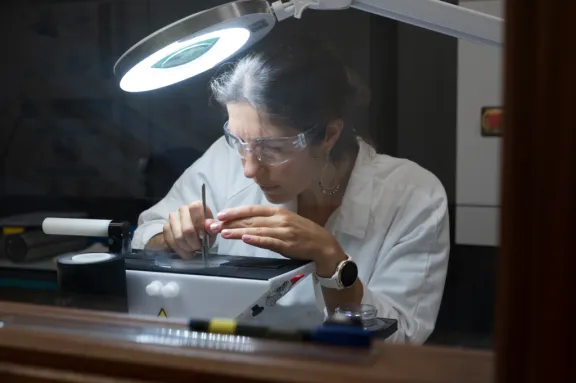Rebekka Wild How do proteins choose their glycosaminoglycan chains?
Rebekka Wild, CNRS researcher, Team leader in the "Structure and Activity of Glycosaminoglycans Group" at the Institut de Biologie Structurale, Grenoble
- 2023 • Impulscience

Glycosaminoglycans are complex chains of sugars found on the surface of cells. Often attached to proteins, they are involved in a wide variety of functions and diseases. With funding from Impulscience®, Rebekka Wild is trying to understand every detail of the molecular machinery responsible for the production of two glycosaminoglycans: heparan sulphate and chondroitin sulphate.
Glycosaminoglycans, essential protein accessories
A large number of proteins called proteoglycans are found on the surface of animal and human cells. They allow the cells to respond to interactions with the surrounding environment, including messenger molecules (such as inflammation molecules), pathogens (such as viruses) and other proteins on the same cell or on neighbouring ones. Glycosaminoglycans (GAGs), long chains of sugars to which proteoglycans are attached, allow them to perform these functions. Two examples of GAGs are heparan sulphate and chondroitin sulphate, which attach to their target proteins when the proteins are being manufactured.
The synthesis of glycosaminoglycans
Once the proteins have been synthesised following precise instructions in the genetic code, they must be folded into the correct shape and modified (by adding GAGs, for example) to become operational proteoglycans. This stage takes place in a cell compartment called the Golgi apparatus. At a specific spot in the protein, the addition of the first building blocks is common to all GAGs. However, the nature of the protein will determine which chain will be attached at the next stage: either a heparan sulphate chain or a chondroitin sulphate chain. The synthesis of each GAG requires specific molecular machinery. The information to know which GAG to make must be contained somewhere in the target protein, but where? What decides which molecular machines need to be set up to generate either a heparan sulphate chain or a chondroitin sulphate chain?
Who is in charge of making decisions?
Although the molecular machines involved in synthesising heparan sulphates and chondroitin sulphates are well known, much remains to be understood about how they work. Rebekka Wild and her team at the Institut de Biologie Structurale in Grenoble will study in detail the machines responsible for producing the two GAGs to gain a better understanding of the differences between them. The team will be able to observe the entire system in its cellular environment: the Golgi apparatus. This project will provide a comprehensive understanding of the polymerisation of GAG chains at all biological scales, from molecules to cells, laying the foundations for future research on the function of GAGs in health and disease.
Rebekka Wild in a few words
Rebekka Wild did her PhD work at the Max Planck Institute in Tübingen in Germany and the University of Geneva in Switzerland before joining the ETH Zurich to study the molecular machines that attach sugars to proteins in yeast using cryo-electron microscopy. In 2019, she was recruited by the CNRS and obtained the ATIP-Avenir grant in 2020 to create her own research team. The team she leads at the Institut de Biologie Structurale in Grenoble is working to understand glycosylation mechanisms at the molecular level by combining structural biology approaches with in vitro and in vivo functional analyses.

Impulscience
Impulscience allocates 7 new grants each year to researchers in the life sciences. Focused on the mid-career, this program aims to support this crucial stage for the development of research projects.
All the award-winners




